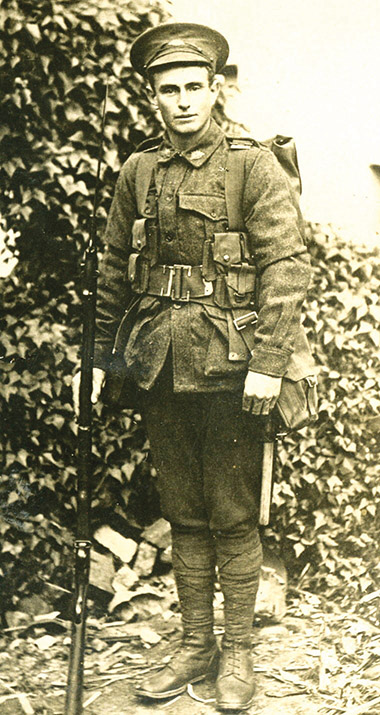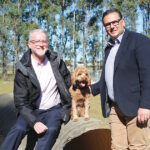Photo of Harry from the Society’s WW1 files.
By Lyn Forde – President/Research Officer of St Marys & District Historical Society Inc.
THERE once was a lad named Harry Adams, born in St Marys in 1891. His parents Charles William and Elizabeth (Rope) lived in Gidley Street. His mother died in 1895 and father in 1897. They are both buried at St Mary Magdalane cemetery in St Marys. Harry was an “Old Boy” of St Marys Public School in Princess Mary Street. At the age of 25 Harry felt he needed to do his bit for the war effort and joined up at Bathurst in 1916. He was now Private No. 5972 in the 1st A.I.F 4th Infantry, 13th Battalion. Five months later in August, Harry sailed to England from Sydney on the HMAT Wiltshire (A18). Harry saw active service on the Western Front in September where the last attack by the Australians at Pozieres started just before dawn when the British and Canadians took over the fighting. The AIF had been placed seven times at Pozieres and had lost over 23,000 officers and men. They were next sent to Ypres and by the 9th October the 1st, 2nd & 5th Divisions of the AIF were ordered back to the Somme. On the 10th December a letter was received from Harry to a family member, written from the trenches somewhere on active service on the Western Front. The letter to St Marys Cheer Fund says, “Dear Friends, your parcel of Christmas goods was received this morning. I thank you heartily for sending them to me. You know the boys heartily appreciate a letter or a parcel from home. Things are not the same here as at home. It is bitterly cold and snowing and raining all the time. The snow is falling thickly while writing this letter. I have had six days furlough that I spent in London. It is a great city, full of beautiful buildings and scenery that is quite different to good old Sydney. The people here cannot make us chaps out because we are so cheerful. Well, I would not mind being home for a few days at Christmas but never mind, I can only hope to be back for the following one. I was expecting to have a month’s spell but it cannot be done as we must relieve the 2nd Division. They will be able to have Christmas out of the firing line lucky beggars. It was quite a shock when I got the parcel this morning. I came in from outpost duty and one of my mates said to me “I say, Digger, there’s a parcel up top for you!”. We call everyone “Digger” here, as we have to dig ourselves in from being outed by Fritz.” As his letter was being read in Sydney, Harry was sent back to England and admitted to the New Zealand No. 5 Codford Hospital in December. He was in this hospital for 18 hours and was then transferred to the infectious unit at the Salisbury Infectious Hospital in the isolation unit. The hospital statement said that Harry had been ill for three days before the 21st December and had a “marked stiffness and retraction of the neck area”. He was isolated on admission and only one attendant was allowed to see him. By the next day his temperature reached 100 degrees and was observed as “stupid and cannot give any coherent account of his illness”. Harry died of Meningitis contracted at Salisbury Camp England on 7th January, 1917 at the age of 26 years and was buried at Stratford-Sub-Castle St Lawrence Churchyard, 2 miles outside of Salisbury in Wiltshire. A memorial service was held on the 28th January at St Mary Magdalene Church at St Marys. The Rector Reverend W R Bowers, preached a touching service that was attended by many families and friends and a number of cadets, under the charge of Lieutenant A Hope and the Penrith District Band accompanied the singing of the hymns. In June at St Marys, Mrs George Dollin (Harry’s sister) received a sympathetic letter from Lieutenant G Waynflete who was in charge of A Company 4th Battalion at the period of Harry’s death. During his letter Lieutenant Waynflete refers to the deep regret felt by the company at the death of Private Adams who was a general favourite amongst his comrades. Lieutenant Waynflete was in charge of the firing party at Harry’s funeral and remarked that he was impressed with the solemn and sweetness of the service and saying of the deep regret he felt of Private Adams’ death from an attack of meningitis while at camp on Salisbury Plains in England, mentioning that his grave is in a pretty little cemetery from where the spire of the great Cathedral can be seen”. Selina Burgess (Harry’s Aunt) also his “foster mother” applied for a war pension, but she was refused as she was not “depended” on Harry at the time of his enlistment, but later this decision was overturned and she received £1 a fortnight. LEST WE FORGET.
Sources: Nepean Times, Adams Family information Ancestry online, National Archives of Australia Canberra War Memorial Panel 68, Victoria Park War Memorial St Marys.






